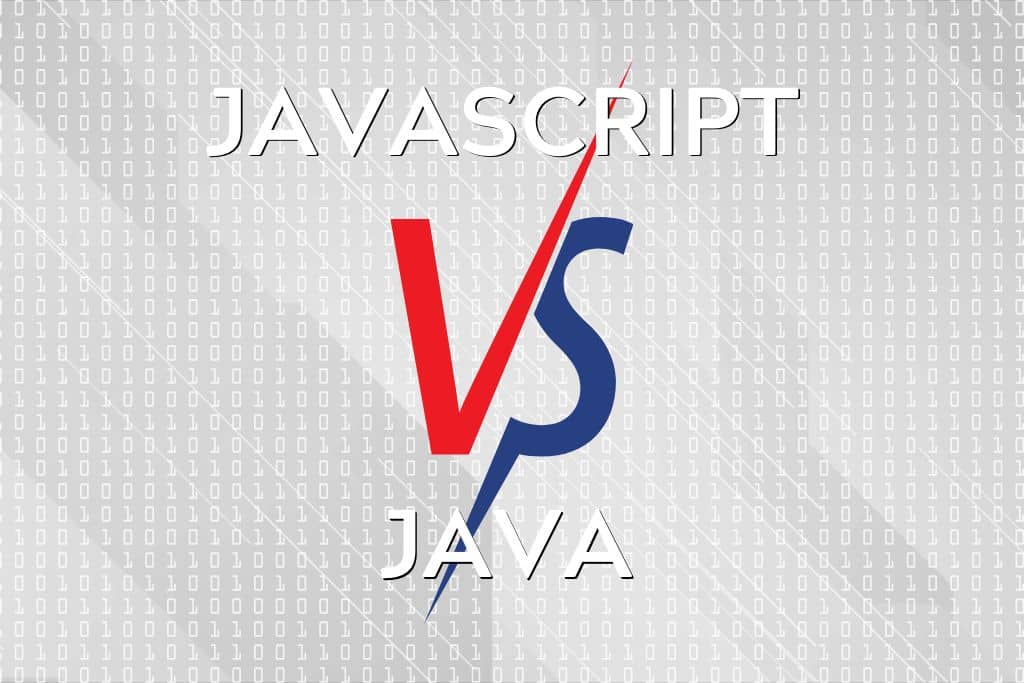JavaScript and Java are like dominos and donuts. Both words start out with a few common letters, but other than that they are very different. Even though both Java and JavaScript are programming languages that originated around the same time, they are used for very different tasks.
So, JavaScript vs Java- what is the difference? JavaScript is a loosely typed prototype-based language that complies with ECMAScript standards, while Java is a strongly typed object-oriented language. JavaScript is directly interpreted by a browser’s JavaScript engine, while Java is first compiled into bytecode before being interpreted by a JVM (Java Virtual Machine).
Clearly, these two languages have very little in common- both in terms of syntax and how they function during runtime. You also need to understand that Java is primarily used for backend operations these days. While JavaScript is a frontend language that works alongside HTML and CSS to create interactive web pages and applications.
Here’s a table comparing the major differences between JavaScript and Java
| JavaScript | Java | |
| What Is It | Loosely typed ECMAScript compliant prototype-based language that’s interpreted during runtime within a browser | Strongly typed object-oriented programming language that is first compiled into bytecode before being interpreted at runtime by the JVM |
| Used For | Creating interactive web pages and web applications in conjunction with HTML and CSS | Creating desktop and Android applications, web apps, Big data, IoT, etc. |
| Created By | Brendan Eich at Netscape | James Gosling and Patrick Naughton at Sun Microsystems |
| Frontend Or Backend | Primarily used for client-side tasks within the browser in conjunction with HTML and CSS, although it can be ran on a server through Node | Primarily used for server-side tasks, but can just as easily work client-side since all it needs is a runtime environment |
| Popularity | One of the top 3 most popular languages in the world alongside Python and Java | One of the top 3 most popular languages in the world alongside JavaScript and Python |
| Syntax And Coding | Much more flexible and “human-friendly” since it’s prototype based and you don’t have to wrap everything inside classes | Code is more cumbersome and takes longer to write since everything has to be wrapped in a class with variable types declared beforehand |
| Application Build Time | Easy to get started and launch your app, but code gets progressively harder to maintain over time | Takes longer to build your app at the start, but you generally spend less time on maintenance as things move on |
| Time Needed To Learn | One of the easier languages due to its flexibility and “human-friendly” syntax | Takes slightly longer to learn the ins and outs of Java because of its more “rigid” nature |
How JavaScript Was Created

If you think about it, JavaScript and Java have a shared history. They were both created for very different purposes but came about during the same time. In fact- Netscape originally approached Sun Microsystems to integrate the (then new) Java language into their Navigator 2.0 browser.
HTML alone wasn’t sufficient to create interactive web pages. And in the early days of the world wide web, you barely did anything more than click on hyperlinks after reading through a static page of text. Okay, sometimes the text would be colored- but that’s all you got.
Netscape came up with Navigator in 1994, which was inspired by Mosaic. Navigator helped computer users take the next step into exploring an interconnected world, by providing them with a GUI. But Netscape wanted to make the webpages and applications themselves more interactive so you weren’t just staring at text.
Check out my other Javascript comparison JavaScript vs jQuery What Is The Difference?
And that’s when they hired a programmer by the name of Brendan Eich, who was tasked with creating a high-level language for their upcoming Navigator 2 browser. He worked relentlessly, creating the first version of JavaScript within a mere 10 days. Its syntax was clearly inspired by C and Java, but it functioned very differently.
You may not know this, but JavaScript started out with the name “Mocha” which transformed into “LiveScript” before taking on the final title of JavaScript. But why? Netscape had originally made an agreement with Sun Microsystems for a licensing deal to use Java with their browser.
Microsoft’s Internet Explorer had just dropped, and the guys at Netscape were very concerned, to say the least. Java never made it into the Navigator browser. But the name stuck, and it sure helped with marketing purposes.
How Java Was Created
Java has had quite an interesting career. It started out super popular in 1996 when Sun Microsystems initially released it. Then, it gradually lost traction and was accused by many of being inferior to other languages.
However, Java is still one of the most widely used programming languages today- right next to Python and JavaScript. So how did this roller coaster begin? The project was initially started by James Gosling and his team in June of 1991.
These days, interactive television and smart TVs are nothing special. But imagine someone creating an entire programming language back in the early 1990s for this specific task. When people were still using VHS and TVs that had those weird bunny-ear antennas on top.
If you are interested in learning more about Javascript compression, check the following article JavaScript vs Ajax What Is The Difference?
That’s right, Java originally started out as a language for digital set-top boxes and smart TVs. But the cable companies and set-top box manufacturers just weren’t ready. And the team initially dabbled with some C++ but found that it was using too much memory.
Java started out as “Oak”. James Gosling gave it this name based on an oak tree outside his office window. But guess what- someone else had trademarked the name “Oak” so the team decided to call their baby “Java” (inspired by coffee beans).
Nowadays, Java is used pretty much everywhere. Applications on your desktop and phone, IoT, servers, and even washing machines. The first version was released in January of 1996 (right alongside JavaScript and Netscape Navigator 2).
Comparing The Usage

JavaScript is primarily used for frontend (client-side) tasks involving user interaction with web pages and web applications. For example- when you press a button on your banking page to view the remaining balance in an account, it sends an AJAX request to the server. All scripting for this interaction is handled by JavaScript which picks up your input and runs a function that decides what to do with it.
You will also see JavaScript being used on servers via a tool called Node. Which is a special JS runtime environment using Chrome’s V8 engine that enables developers to run JS outside a browser. JavaScript can also be seen in web apps and browser/ mobile games.
In most web development work, JavaScript is rarely used by itself. For web pages, it functions alongside HTML (which gives the structure) and CSS (which provides the style). Often, JavaScript is used within frameworks such as React or Angular.
Now, moving on to Java. Java is generally used for server-side work or embedded applications. It is also integral to big data, cloud-based enterprises, and IoT communities.
Java is the language of choice for various SDKs and IDEs such as IntelliJ IDEA, Eclipse, NetBeans, etc. Its long history is filled with tons of documentation, APIs, libraries, etc. which make Java a very versatile language. Java is used everywhere because it’s scalable, supports multi-threading, and works across a wide range of platforms.
Comparing The Syntax And How They Work
Java is often referred to as a “strongly-typed” or statically typed language. But what does this mean? Okay, let’s say you’re writing a simple program to add two integers with variables declared as “a” and “b”.
In Java, you have to preface the variable with its type before you assign any values. So it would be something like “int a = 4” and “int b = 7” for the operation 4 plus 7. And once you’ve declared “a” as an integer type, you can’t modify it into a different type like a string, array, etc.
JavaScript is a lot more lenient in this aspect. You can have the same addition program, with the code written as “let a = 4” and “let b = 7”. And later, you can even store arrays or strings in these variables- no need for static types that stay throughout the lifespan of the variable.
Another big difference between the two is that Java is class-based while JavaScript is prototype-based. Think of a Java class as a template for each object you create. Say you want to have a database for the local dog shelter, so you create the “dog” class within your Java code.
Each individual instance of this dog object will have various types and variables based on its class template. Like name, breed, color, weight, etc. In Java, just about everything has to be packed up inside a class of some kind.
JavaScript also has these class constructs but they aren’t necessary, and you can write code that is far simpler than Java for the same task. Since JavaScript is prototype-based, it only has objects. And each object can be its own template or a reference “prototype” for other objects.
Object properties can be defined during creation, and modified during runtime. To implement an inheritance model, you simply clone prototypes of existing objects. As you can see, JavaScript code is a lot more “free-flowing” and “lenient” compared to Java.
Comparing The Popularity

Java and JavaScript are constantly in the top 3 as the most-used programming languages across a variety of tech sectors. Both have their unique niches and fulfill different roles. JavaScript is currently more widely used among web developers.
In recent times, Java has had to contend with Python, which is infiltrating many of the markets that Java once dominated. Java by nature requires more time and effort, but it’s got unique strengths that you won’t get in JavaScript. A general opinion is that Java apps take longer to launch, but require less maintenance and debugging over time when compared to JavaScript apps.
Comparing The Time Need To Learn Each Language
Basic Java isn’t all that hard to learn, but you still have to keep in mind the fact that it’s class-based and statically typed. Plus, the environment to learn and develop a basic Java program requires more bits and pieces. You need to select a Java version, get an IDE, tell your tools where you installed Java, etc.
To start with JavaScript, you can literally just open any browser and paste in some code you wrote in the Notepad app. JavaScript’s syntax is also more “human-friendly”, and you write fewer lines of code in general. But as you learn more about either language, you’ll find out that they both require years of practice and experience in order to master.
Conclusion
Both Java and JavaScript have a rich history in web and app development, with tons of libraries and APIs. JavaScript’s development environment within which it exists is a lot more dynamic. And constantly changing with the introduction of new tools and frameworks.
Java, on the other hand, has been facing a lot of stiff competition from rival languages like Python. However, both of these are still within the top 3 programming languages used by developers across the world. And they have their unique strengths (as well as weaknesses).

